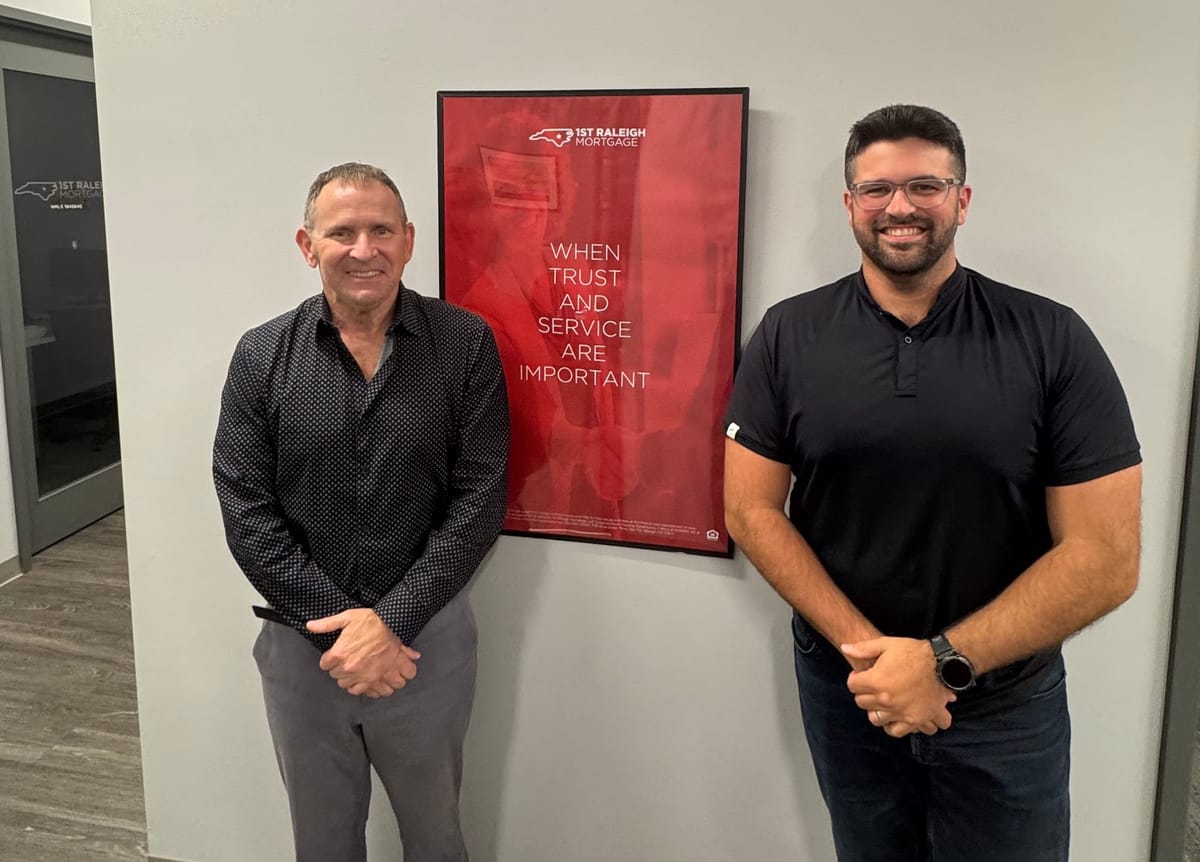Maximizing Mortgage Knowledge with 1st Raleigh Mortgage

Mortgage planning can be complex, and making informed choices is crucial—whether you're a first-time buyer, a current homeowner, or a real estate agent supporting clients. Mike Brosmith, an experienced mortgage professional at First Raleigh Mortgage, recently shared valuable insights on how to navigate today’s mortgage landscape. Here’s a guide based on Mike’s advice, tailored for first-time buyers, current homeowners, and real estate agents, to make mortgage decisions more approachable and beneficial.
About Mike and 1st Raleigh Mortgage
Mike entered the mortgage industry in 2001, coming from a background in corporate accounts at Stanley Tools and Liberty Hardware, where he handled major accounts like Home Depot and Lowe’s. When the 2001 recession led to job cuts, a friend suggested he try mortgage lending. After spending a few days shadowing his friend, Mike recognized his potential in the field.
Starting his career during a refinance market, Mike leveraged his strong network in the community to grow his client base. He spent over a decade at CFL Mortgage, where he managed a profit-sharing branch before joining 1st Raleigh Mortgage. At First Raleigh, a mortgage brokerage, Mike serves as an in-house lender with access to multiple lending options, giving clients a one-stop solution for their mortgage needs. His longstanding experience allows him to guide clients through the intricacies of the mortgage process, ensuring they find the best rates and terms.
For First-Time Homebuyers
1. Key Mortgage Options for New Buyers
Mike emphasizes that first-time buyers have several flexible loan options that lower financial barriers to homeownership:
- Home Ready and Home Possible Programs: Created by Fannie Mae and Freddie Mac, these programs require only a 3% down payment, compared to the standard 5%, and offer slightly lower interest rates and private mortgage insurance (PMI) premiums.
- One Plus Loan Program: This innovative program provides a 2% grant for the down payment, making the buyer’s required down payment just 1%. The grant is forgiven at the time of closing, making it a beneficial option for buyers with limited cash upfront.
- 2-1 Buydown Loan: With this structure, the buyer locks in a fixed rate but benefits from a lower starting rate, reduced by 2% in the first year and by 1% in the second year, allowing them to “grow into” the loan as they become more comfortable with homeownership costs.
- Down Payment Assistance Programs: For those needing extra help, these programs offer a second mortgage to cover the down payment. While they usually come with slightly higher rates due to the high loan-to-value (LTV) ratio, they are often paired with FHA or first-time buyer loans, making them an accessible route into homeownership.
2. Optimizing Credit for a Better Rate
A good credit score is essential for securing favorable mortgage terms. Mike offers these tips for improving and managing credit scores:
- Maintain Low Balances: Keep credit card balances below 30% of available limits to positively impact your score. If you’re nearing your credit limit, try to shift or consolidate balances to maintain a healthy ratio.
- Avoid Late Payments: Consistently making on-time payments is crucial for maintaining a solid credit score.
- Use Credit Simulators and Repair Services: For those looking to improve their scores, Mike uses a credit simulator to create customized plans. For more in-depth needs, he recommends a reputable service, My Credit Guy, which has a transparent approach and communicates regularly with clients and agents.
3. Common Pitfalls to Avoid
Many first-time buyers encounter hurdles during the mortgage process. Mike highlights a few potential pitfalls to steer clear of:
- Maintain Steady Employment: For hourly workers, lenders prefer at least one to two years of consistent employment to better estimate income stability. For salaried roles, this is less critical, but sudden job changes are generally discouraged.
- Avoid Opening New Credit Accounts: Opening new lines of credit during the mortgage process can affect your score. Once your initial credit report is pulled, Mike advises against applying for new credit or making large purchases until after closing.
4. Timeline and Importance of Pre-Approval
The typical mortgage process spans about 30 days from contract to closing, although it can be expedited if the buyer is highly responsive. Mike stresses the importance of securing pre-approval before beginning a home search. Not only does this provide a budget but also helps buyers set realistic expectations. Mike often gives clients two figures: the maximum they qualify for with the lender and a more conservative limit based on their financial goals, ensuring they don’t overstretch.
For Current Homeowners
1. When and Why to Refinance
Refinancing can provide a strategic way to reduce monthly payments, access home equity, or pay off your mortgage faster. Mike shares these key points:
- Rate Reduction Targets: Generally, a rate reduction of 0.75% to 1% makes refinancing worthwhile. Short-term homeowners should aim for at least a 1% rate improvement to ensure they recoup closing costs within a reasonable timeframe.
- Considering Closing Costs: Closing costs are usually rolled into the loan, but it’s essential to calculate how long it will take to recover these costs through lower monthly payments. For long-term homeowners, even a slight rate reduction can be beneficial.
2. Mortgage Options for Investment Properties
Investing in real estate requires specific mortgage solutions, and Mike outlines the best options:
- Conventional Loans: A standard conventional loan is ideal for investment properties. However, rates for these loans are typically 0.5%–0.75% higher than for primary residences due to increased risk.
- Debt Service Coverage Ratio (DSCR) Loans: For investors with high debt or variable income, DSCR loans offer a no-income, no-employment alternative. Qualification is based solely on rental income covering the mortgage payment, making it an efficient option for experienced investors.
3. Leveraging Home Equity
Homeowners looking to tap into their equity for renovations or other expenses have three main options:
- Cash-Out Refinance: This approach consolidates high-interest debts into a single, lower-rate loan. It replaces your existing mortgage with a new, larger one, allowing you to access cash based on your home’s equity. This strategy combines both debts into one, potentially at a lower rate.
- Home Equity Loan: As a second mortgage with a fixed rate, a home equity loan provides a lump sum for renovations or large expenses. The predictability of fixed payments makes it easier to budget.
- Home Equity Line of Credit (HELOC): Operating like a credit card, HELOCs allow borrowers to withdraw funds as needed and pay them back with flexibility. While these lines have adjustable rates, they can be beneficial if rates are on a downward trend, as they currently are.
HELOCs and Adjustable Rates
Since HELOC rates are variable, they change with the prime rate, which the Federal Reserve can adjust. Mike notes that while rates are expected to trend downwards over the next year, adjustable rates always carry a degree of uncertainty.
For Real Estate Agents
1. Building Strong Lender Relationships
A solid partnership with a lender can be a game-changer for agents. Mike emphasizes that real estate transactions don’t adhere to a 9-to-5 schedule, so agents benefit from working with lenders who are responsive during nights and weekends. Equally important is a lender’s ability to process loans efficiently and communicate proactively.
2. Staying Informed About Market Trends
Mortgage rates have risen steadily, affecting buyer affordability. Mike suggests that agents stay up-to-date with rate trends, as a pre-approved buyer might not qualify if rates increase significantly. By keeping in close communication with lenders, agents can better support clients and adjust quickly to market shifts.
3. Helping Clients Through the Financing Process
Navigating mortgage underwriting can be a challenging, highly detailed process. Here’s how agents can assist:
- Prepare Clients for Underwriting: Mike explains that mortgage underwriting is a thorough, investigative process. Clients should expect requests for documentation and be ready to provide it promptly, as resistance or delays can slow the process.
- Encourage Patience and Cooperation: Because underwriting involves verifying even minor details, clients should remain cooperative and responsive, which helps ensure a smooth closing process.
4. Using Lender Insights to Enhance Client Support
Mike encourages agents to work closely with lenders who can keep them informed on lending guidelines and interest rate changes. This ongoing education allows agents to give more accurate advice to clients, boosting their trust and confidence.
Conclusion
Mike’s extensive knowledge of the mortgage industry provides valuable insights for new buyers, current homeowners, and agents alike. By understanding the available options, optimizing credit, exploring refinancing, and staying informed about market trends, buyers and agents can make informed, strategic decisions. For more guidance on navigating the mortgage process, reach out to Mike at 1st Raleigh Mortgage—a trusted partner for all your mortgage needs.


